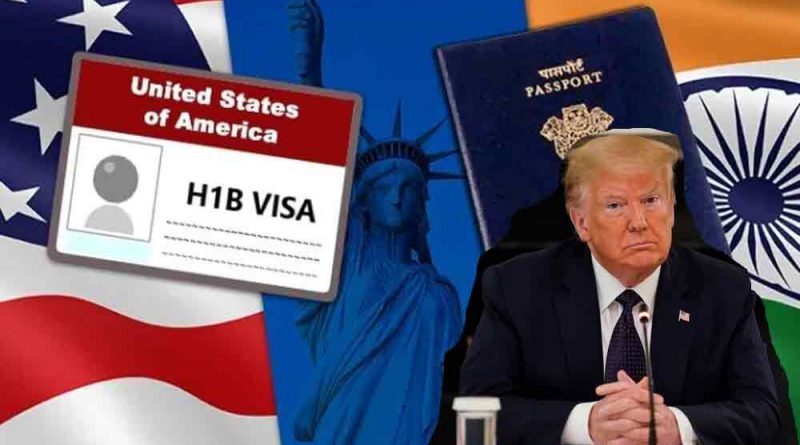Trump’s H-1B Visa Fee Sparks Strategic Overhaul in India’s IT Sector
The visa fee comes at a time when the Indian IT sector is already grappling with weak revenue growth in its primary U.S. market.
In a sweeping move that has sent shockwaves through India’s $283 billion information technology industry, U.S. President Donald Trump has imposed a $100,000 fee on new H-1B visa applications, effective Sunday. The decision, which comes amid broader efforts to reshape America’s immigration and labor policies, is poised to disrupt decades of talent mobility and outsourcing strategies that have underpinned the success of Indian IT giants.
A Sector at Crossroads
India’s IT sector, which derives nearly 57% of its revenue from the U.S. market, has long relied on the H-1B visa program to rotate skilled professionals into client-facing roles across American corporations. This model has been central to delivering software services and business solutions to major firms such as Apple, JPMorgan Chase, Walmart, Microsoft, Meta, and Google.
According to U.S. government data, India accounted for a staggering 71% of approved H-1B beneficiaries last year, with China trailing at 11.7%. The new fee, however, threatens to upend this dominance and force Indian firms to recalibrate their global delivery models.
“The American Dream Will Be Tough”
Ganesh Natarajan, former CEO of Zensar Technologies, described the development as a major setback for aspiring Indian professionals. “The ‘American Dream’ for aspiring workers will be tough,” he said, predicting a sharp decline in cross-border travel and a pivot toward offshore operations in India, Mexico, and the Philippines.
Major Indian IT firms — Tata Consultancy Services (TCS), Infosys, HCLTech, Wipro, and Tech Mahindra — declined to comment on the policy shift, despite its potential to reshape their workforce strategies.
Ripple Effects on Innovation and Continuity
Industry body Nasscom warned that the move could have “ripple effects on America’s innovation ecosystem” and disrupt business continuity for onshore projects. Madhavi Arora, Chief Economist at Emkay Global, added that services exports have now been dragged into the global trade and tech war, with implications for margins and supply chains.
Phil Fersht, CEO of HFS Research, noted that client-facing roles will be constrained, affecting deal conversions and project timelines. “Clients will demand repricing or delay start dates until there is clarity on legal challenges. Some projects will be re-scoped to reduce onshore staffing. Others will shift delivery offshore or near-shore from day one,” he said.
Legal Uncertainty and Visa Selectivity
The announcement has triggered chaos and confusion among immigration lawyers and corporate HR departments. Trump’s proclamation accused the IT sector of manipulating the H-1B system, prompting a flurry of calls to legal firms over the weekend.
Vic Goel, managing partner at U.S. law firm Goel & Anderson, said the steep fee would force companies to become highly selective. “We expect that companies will reserve H-1B filings for only the most business-critical roles. This would significantly reduce access to the H-1B program for many skilled foreign nationals and could reshape employer demand,” he explained.
Before the White House clarified that the fee applies only to new applicants — not existing visa holders or those seeking renewals — companies such as TCS, Eli Lilly, Microsoft, JPMorgan, and Amazon advised employees on H-1B visas to either remain in the U.S. or return before the deadline. Internal messages seen by Reuters revealed that many workers from India and China had to abandon travel plans and rush back to the U.S.
Sophie Alcorn, CEO of Alcorn Immigration Law, expects legal challenges to emerge imminently. “We are anticipating that several lawsuits will be immediately forthcoming this week,” she said.
Compounding Challenges: Tax Proposals and Market Headwinds
The visa fee comes at a time when the Indian IT sector is already grappling with weak revenue growth in its primary U.S. market. Clients have been deferring non-essential tech spending amid inflationary pressures and tariff uncertainty. Adding to the strain is a proposed 25% tax on outsourcing payments, which could further erode margins and competitiveness.
Global Capability Centres: A Strategic Pivot
Amid the turbulence, industry experts foresee accelerated growth in Global Capability Centres (GCCs) — offshore hubs that support operations, finance, and R&D. These centres, once viewed as cost-saving back offices, are now evolving into strategic innovation engines.
Steven Hall, President and Chief AI Officer at ISG, highlighted the geographic shift. “Time zone proximity will accelerate GCCs and resourcing in Canada, Mexico, and Latin America, where talent is stable and cost advantages remain,” he said. “GCCs in India will also continue to rise with broader capabilities and skills as enterprises shift strategic roles to India.”
India already hosts more than half of the world’s GCCs and is projected to accommodate over 2,200 such centres by 2030. According to a Nasscom-Zinnov report, the market size could approach $100 billion and generate up to 2.8 million jobs.
A New World Order in Services Economics
Ray Wang, founder and chairman of Silicon Valley-based Constellation Research, believes Trump’s move will catalyze a fundamental shift in global services. “We are seeing a new world order on services economics,” he said. Wang anticipates more GCCs in India, increased local hiring in the U.S., heightened pressure to deliver automation and AI, reduced outsourcing, fewer H-1B visas, and diminished job mobility.
A Strategic Inflection Point
Trump’s H-1B visa fee marks a pivotal moment for India’s IT sector. As firms scramble to adapt, the contours of global talent deployment, client engagement, and delivery models are being redrawn. While the immediate impact may be disruptive, the long-term trajectory could usher in a more diversified and resilient framework — one that balances offshore innovation with onshore integration.
For India’s tech titans, the challenge now lies in navigating this new terrain with agility, foresight, and strategic clarity.


